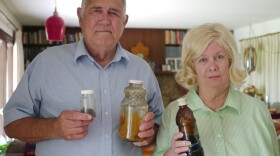Bonita and Patrick Jones found their dream retirement home in Azle. It’s not far from where dozens of minor earthquakes started shaking the ground six months ago. Now the Joneses are worried about the value of their property and the environment.
The sunset hits the 2,200-square foot home almost perfectly. It glows a soft orange-red on five acres of wild prairie northwest of Fort Worth. There’s a natural spring creek that runs out back, a brown barn, horses. The last thing Bonita and Patrick Jones expected to see, and hear, was a parade of 18 wheelers.
“When we first moved here, we watched all the water trucks, constant, go up and down the street,” she said. “And of course as you can see, our street’s shrinking.”
Trucks were rumbling along their little country road, before dawn, after the sun went down, and on the weekends. So, one day, they stopped a driver and asked about the water.
“And the guy did tell us,” Bonita said. “You wouldn’t want this water, its waste, water from the injections. So I know that’s what it is.”
A disposal site, also called an injection site, includes waste water or water from oil and gas drilling from the Barnett Shale. The site is within walking distance. Before moving to Azle from Fort Worth four years ago, she didn’t know what an injection well or disposal well was. But now she does.
“Every well is supposed to be identified, supposed to have a number that you can go and pull up and find that well on the Railroad Commission,” she said. “This well is not on their site. They don’t even have a number there, and we know it’s a disposal site.”
The site is fenced with a sign that says EnerVest, but no identifiable number. The Houston-based company has some 28,000 wells in 17 states. KERA called EnerVest and the Railroad Commission of Texas to identify this site, but calls weren't returned.
“Our concern is one of the benefits of buying this property that we were saving for, is it does have a well on it," Patrick Jones said.
He’s talking about a natural water well.
“And it does feed, the well is supplying all our horse barns out back,” he said. “All the systems, anything that is non-drinkable."
Bonita Jones said: "Right, you grow vegetables, whatever, that’s where your waters coming from -- it’s the well.”
And then there are the earthquakes.
“To me, its common sense, OK,” Bonita Jones said. “You’re forcing stuff into the ground. Yes, you’re going to cause some unnatural things."
Patrick Jones said: "For a year and a half, two years, we were here, there was nothing. And then it started happening twice a day, at least once every other day. There’s got to be a reason that all of a sudden, all the seismic activity was occurring.”
The Joneses say after the media reported on the many small earthquakes in November and December, mostly under magnitude 4.0, the water trucks were seen less.
“Well now, it’s been quiet,” Bonita Jones said. “Earthquakes have slowed down, and everything, and they’re cranking right back up.”
They’ve started hearing the trucks again, at 4:30 a.m., and hours after they go to bed. If oil and gas companies continue to drill waste water deep underground, they worry about another round of earthquakes.
This is the fifth of several stories in a series called "What's Behind the North Texas Quakes?"
Earthquake public forum to be held June 18 in Azle
What’s behind the earthquakes in North Texas?KERA and StateImpact Texas will host a free public event to explore the issues at 7 p.m. June 18 at the Azle High School Auditorium. Learn more about the forum here.






